Abstract
We have employed a method of enrichment that allows us to significantly increase the rate of reductive polychlorinated biphenyl (PCB) dechlorination. This method shortens the time required to investigate the effects that culture conditions have on dechlorination and provides an estimate of the potential activity of the PCB-dechlorinating anaerobes. The periodic supplementation of sterile sediment and PCB produced an enhanced, measurable, and sustained rate of dechlorination. We observed volumetric rates of the dechlorination of 2,3,6-trichlorobiphenyl (2,3,6-CB) to 2,6-dichlorobiphenyl (2,6-CB) of more than 300 μmol liter-1 day-1 when the cultures were supplemented daily. A calculation of this activity that is based on an estimate of the number of dechlorinating anaerobes present indicates that 1.13 pmol of 2,3,6-CB was dechlorinated to 2,6-CB day-1 bacterial cell-1. This rate is similar to that of the reductive dechlorination of 3-chlorobenzoate by Desulfomonile tiedjei. Methanogenesis declined from 585.3 to 125.9 μmol of CH4 liter-1 day-1, while dechlorination increased from 8.2 to 346.0 μmol of 2,3,6-CB dechlorinated to 2,6-CB liter-1 day-1.
Full text
PDF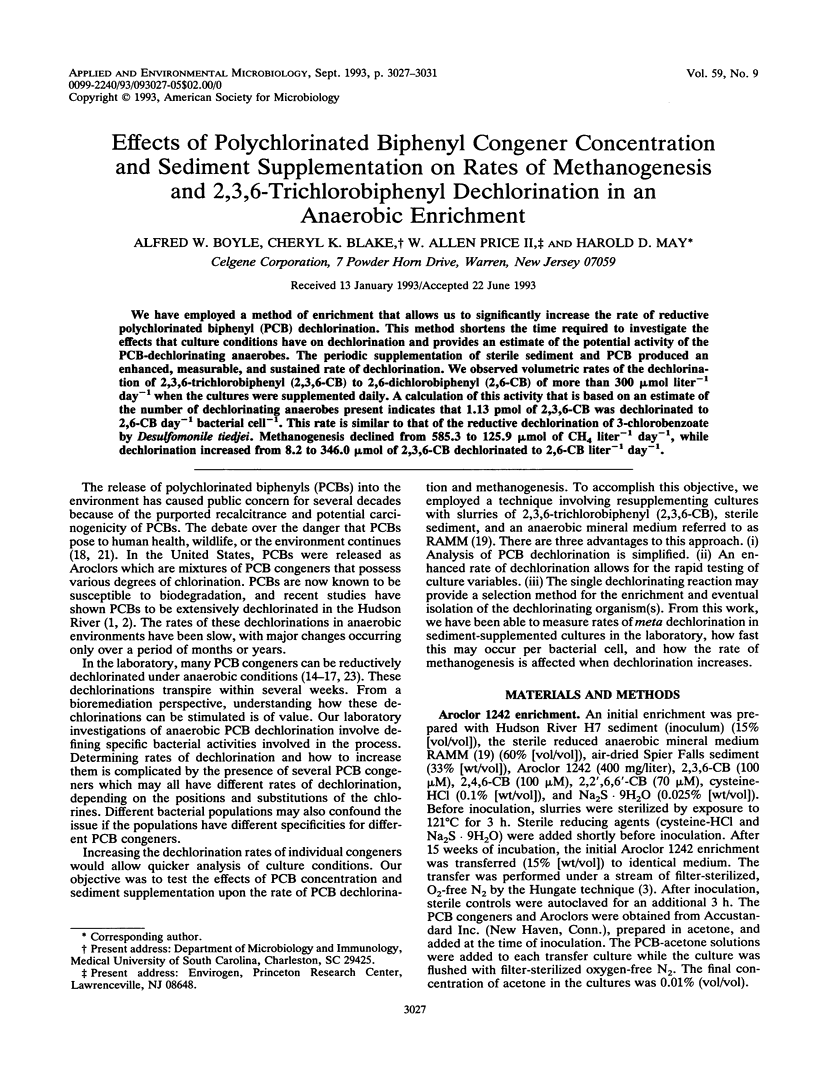
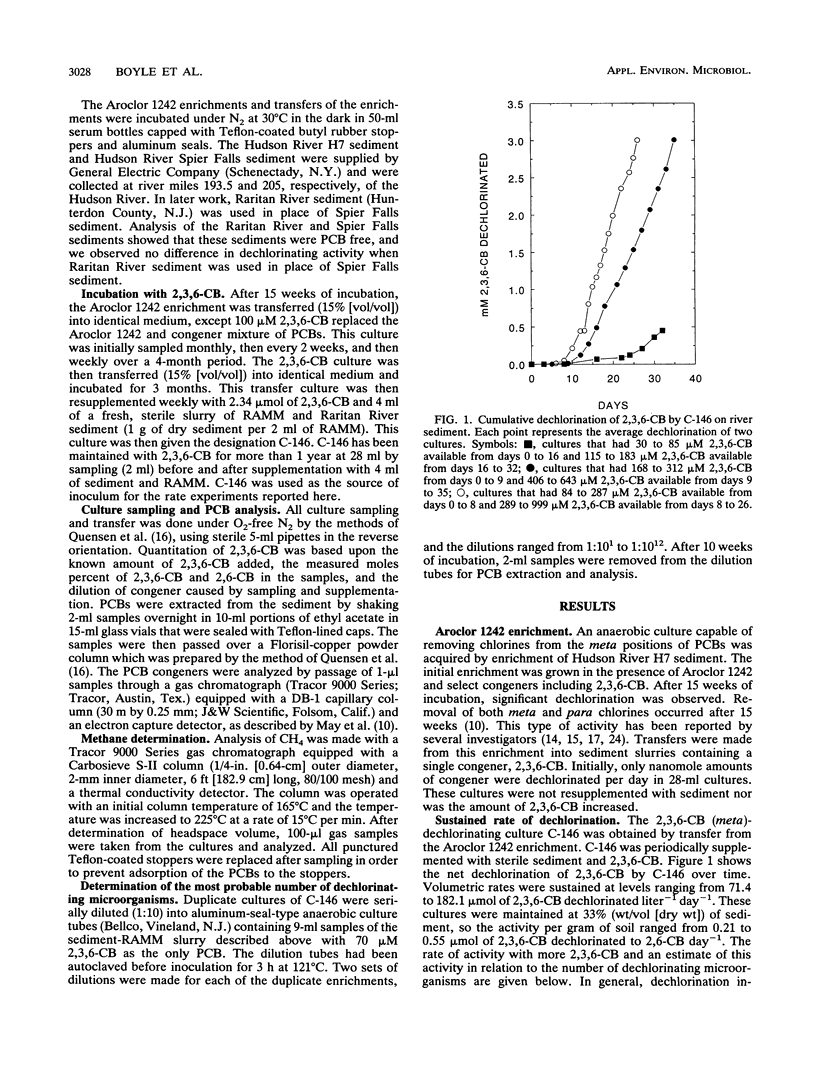
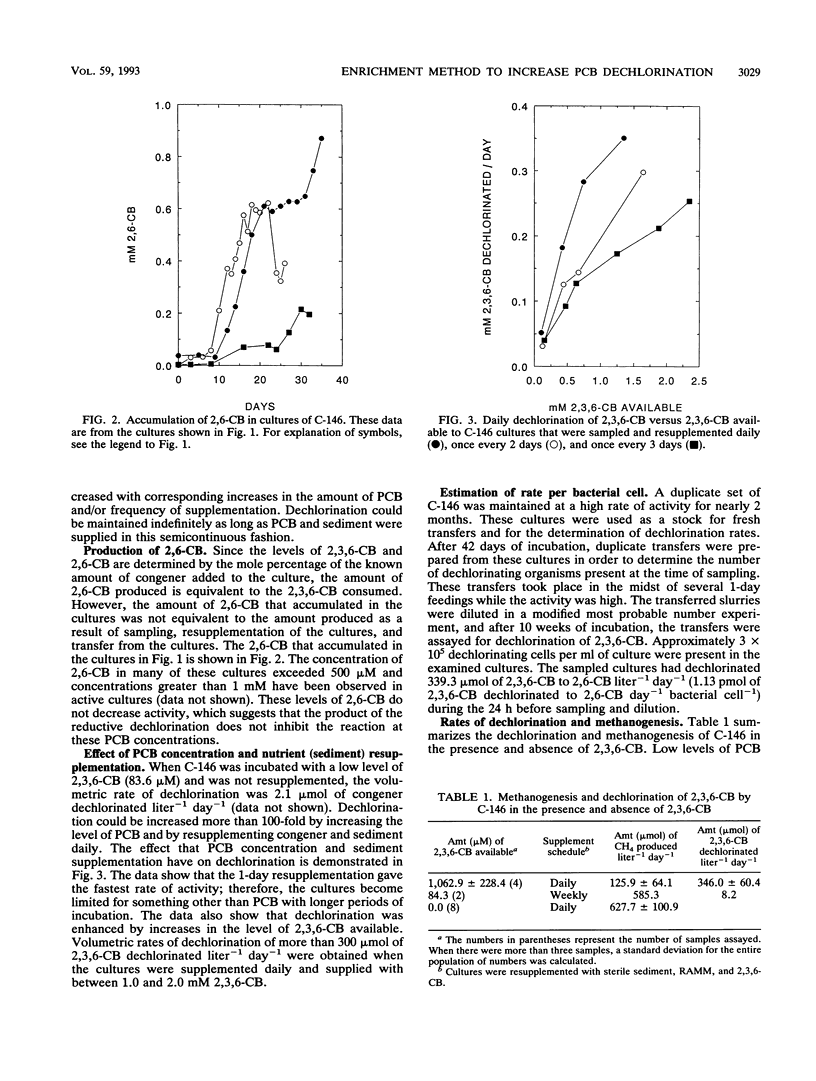
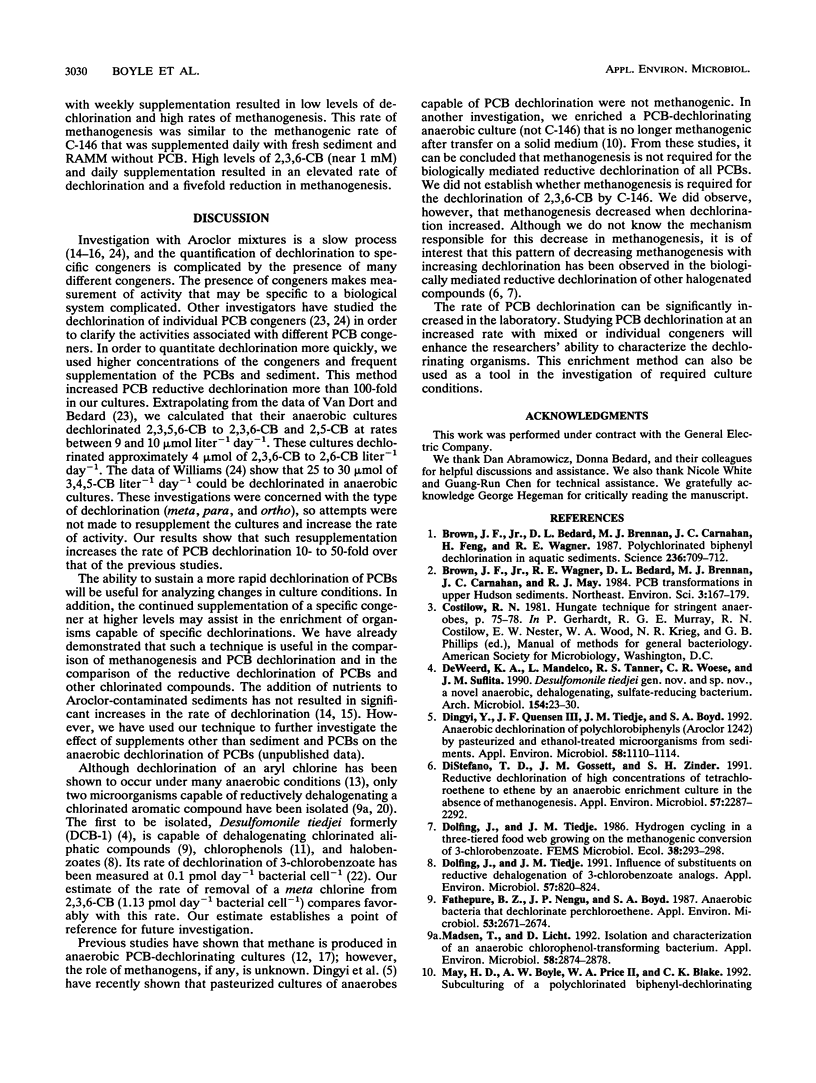
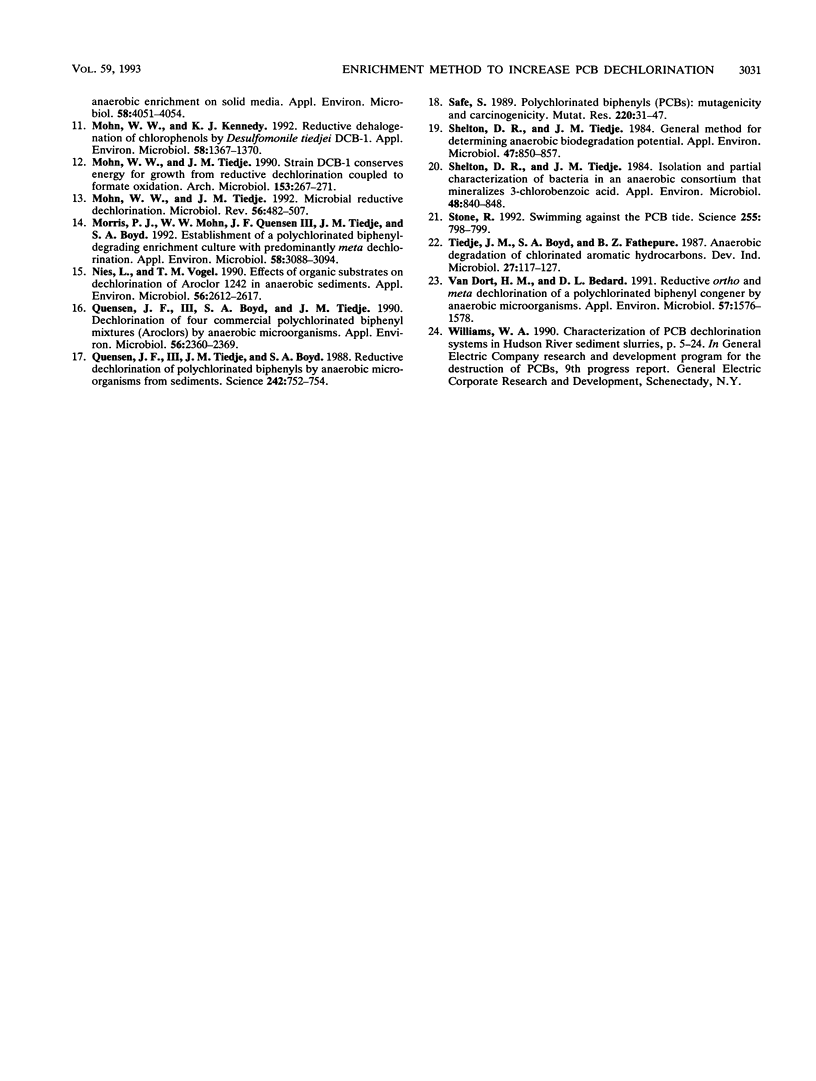
Selected References
These references are in PubMed. This may not be the complete list of references from this article.
- Brown J. F., Jr, Bedard D. L., Brennan M. J., Carnahan J. C., Feng H., Wagner R. E. Polychlorinated biphenyl dechlorination in aquatic sediments. Science. 1987 May 8;236(4802):709–712. doi: 10.1126/science.236.4802.709. [DOI] [PubMed] [Google Scholar]
- DiStefano T. D., Gossett J. M., Zinder S. H. Reductive dechlorination of high concentrations of tetrachloroethene to ethene by an anaerobic enrichment culture in the absence of methanogenesis. Appl Environ Microbiol. 1991 Aug;57(8):2287–2292. doi: 10.1128/aem.57.8.2287-2292.1991. [DOI] [PMC free article] [PubMed] [Google Scholar]
- Dolfing J., Tiedje J. M. Influence of substituents on reductive dehalogenation of 3-chlorobenzoate analogs. Appl Environ Microbiol. 1991 Mar;57(3):820–824. doi: 10.1128/aem.57.3.820-824.1991. [DOI] [PMC free article] [PubMed] [Google Scholar]
- Fathepure B. Z., Nengu J. P., Boyd S. A. Anaerobic bacteria that dechlorinate perchloroethene. Appl Environ Microbiol. 1987 Nov;53(11):2671–2674. doi: 10.1128/aem.53.11.2671-2674.1987. [DOI] [PMC free article] [PubMed] [Google Scholar]
- Madsen T., Licht D. Isolation and characterization of an anaerobic chlorophenol-transforming bacterium. Appl Environ Microbiol. 1992 Sep;58(9):2874–2878. doi: 10.1128/aem.58.9.2874-2878.1992. [DOI] [PMC free article] [PubMed] [Google Scholar]
- May H. D., Boyle A. W., Price W. A., 2nd, Blake C. K. Subculturing of a polychlorinated biphenyl-dechlorinating anaerobic enrichment on solid media. Appl Environ Microbiol. 1992 Dec;58(12):4051–4054. doi: 10.1128/aem.58.12.4051-4054.1992. [DOI] [PMC free article] [PubMed] [Google Scholar]
- Mohn W. W., Kennedy K. J. Reductive dehalogenation of chlorophenols by Desulfomonile tiedjei DCB-1. Appl Environ Microbiol. 1992 Apr;58(4):1367–1370. doi: 10.1128/aem.58.4.1367-1370.1992. [DOI] [PMC free article] [PubMed] [Google Scholar]
- Mohn W. W., Tiedje J. M. Microbial reductive dehalogenation. Microbiol Rev. 1992 Sep;56(3):482–507. doi: 10.1128/mr.56.3.482-507.1992. [DOI] [PMC free article] [PubMed] [Google Scholar]
- Mohn W. W., Tiedje J. M. Strain DCB-1 conserves energy for growth from reductive dechlorination coupled to formate oxidation. Arch Microbiol. 1990;153(3):267–271. doi: 10.1007/BF00249080. [DOI] [PubMed] [Google Scholar]
- Morris P. J., Mohn W. W., Quensen J. F., 3rd, Tiedje J. M., Boyd S. A. Establishment of polychlorinated biphenyl-degrading enrichment culture with predominantly meta dechlorination. Appl Environ Microbiol. 1992 Sep;58(9):3088–3094. doi: 10.1128/aem.58.9.3088-3094.1992. [DOI] [PMC free article] [PubMed] [Google Scholar]
- Nies L., Vogel T. M. Effects of organic substrates on dechlorination of aroclor 1242 in anaerobic sediments. Appl Environ Microbiol. 1990 Sep;56(9):2612–2617. doi: 10.1128/aem.56.9.2612-2617.1990. [DOI] [PMC free article] [PubMed] [Google Scholar]
- Quensen J. F., 3rd, Tiedje J. M., Boyd S. A. Reductive dechlorination of polychlorinated biphenyls by anaerobic microorganisms from sediments. Science. 1988 Nov 4;242(4879):752–754. doi: 10.1126/science.242.4879.752. [DOI] [PubMed] [Google Scholar]
- Quensen John F., Boyd Stephen A., Tiedje James M. Dechlorination of Four Commercial Polychlorinated Biphenyl Mixtures (Aroclors) by Anaerobic Microorganisms from Sediments. Appl Environ Microbiol. 1990 Aug;56(8):2360–2369. doi: 10.1128/aem.56.8.2360-2369.1990. [DOI] [PMC free article] [PubMed] [Google Scholar]
- Safe S. Polychlorinated biphenyls (PCBs): mutagenicity and carcinogenicity. Mutat Res. 1989 Jan;220(1):31–47. doi: 10.1016/0165-1110(89)90007-9. [DOI] [PubMed] [Google Scholar]
- Shelton D. R., Tiedje J. M. General method for determining anaerobic biodegradation potential. Appl Environ Microbiol. 1984 Apr;47(4):850–857. doi: 10.1128/aem.47.4.850-857.1984. [DOI] [PMC free article] [PubMed] [Google Scholar]
- Shelton D. R., Tiedje J. M. Isolation and partial characterization of bacteria in an anaerobic consortium that mineralizes 3-chlorobenzoic Acid. Appl Environ Microbiol. 1984 Oct;48(4):840–848. doi: 10.1128/aem.48.4.840-848.1984. [DOI] [PMC free article] [PubMed] [Google Scholar]
- Stone R. Swimming Against The PCB Tide. Science. 1992 Feb 14;255(5046):798–799. doi: 10.1126/science.255.5046.798. [DOI] [PubMed] [Google Scholar]
- Van Dort H. M., Bedard D. L. Reductive ortho and meta Dechlorination of a Polychlorinated Biphenyl Congener by Anaerobic Microorganisms. Appl Environ Microbiol. 1991 May;57(5):1576–1578. doi: 10.1128/aem.57.5.1576-1578.1991. [DOI] [PMC free article] [PubMed] [Google Scholar]
- Ye D., Quensen J. F., 3rd, Tiedje J. M., Boyd S. A. Anaerobic dechlorination of polychlorobiphenyls (Aroclor 1242) by pasteurized and ethanol-treated microorganisms from sediments. Appl Environ Microbiol. 1992 Apr;58(4):1110–1114. doi: 10.1128/aem.58.4.1110-1114.1992. [DOI] [PMC free article] [PubMed] [Google Scholar]


